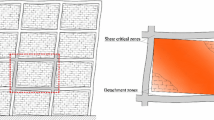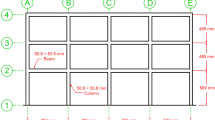Abstract
Addition of reinforced concrete (RC) infill walls into the structural system has been a commonly preferred strengthening technique within the last decades for seismic rehabilitation of RC frames. As a consequence, generating a representative numerical model of an RC infill wall has become an important issue. As the initial step of this study, measured structural responses of two selected well-known large-scale RC infill wall experiments subjected to displacement controlled cyclic loading are taken into account. Later, by calibrating the numerical model prepared in Perform-3D computer program utilizing fiber cross-sections, a practical and a compatible analytical model is obtained and proposed herein. Structural systems of the experiments are mathematically modeled by elements consisting of vertical and horizontal fiber layers to represent the bending/axial behavior and to control the out of plane displacements, respectively. Nonlinear behavior of the reinforcing steel is represented by a tri-linear backbone curve without strength degradation, while a multi-linear hysteretic behavior considering the strength loss is utilized for the structural concrete. Furthermore, those recently conducted experiments are simulated by a couple of widely used hysteretic models for comparative purposes, which are preferred in most cases by the researchers during the analytical investigation of RC structures, so that their adequacy for reflecting the nonlinear behavior of infill walls are also studied. It is shown with comparisons for the experimentally measured and the analytically derived results that the calibrated mathematical model proposed herein is more compatible with the measured values than the widely used hysteretic rules for capturing the behavior of these types of frames retrofitted by RC infill walls under reversed cyclic loading. Although numerical simulations are carried out for a limited number of tests and it is assumed that sufficient amount of anchoring dowels is provided at the interface of the existing frame and the RC infill, the proposed calibrated model conforms to both experiments’ measured responses by means of seismic behavior for not only the undamaged single bay frames converted to the RC infill wall, but also pre-damaged multi-bay strengthened structures, which include structural deficiencies like low concrete strength, inadequate stiffness and insufficient confinement.























Similar content being viewed by others
References
Anil O, Altin S (2006) An experimental study on reinforced concrete partially infilled frames. Eng Struct 29(2007):449–460
Bhaumik L, Raychowdhury P (2012) Seismic response of nuclear reactor buildings incorporating nonlinear soil-structure interaction. Proceedings of the15th WCEE, Lisbon
Canbay E (2001) Contribution of RC infills to the seismic behavior of structural systems. PhD Dissertation, Middle East Technical University, Ankara
Canbay E, Ersoy U, Özcebe G (2002) Betonarme dolgu duvarların yapıların sismik davranışı üzerine etkileri. Research Report No: INTAG 563, Scientific and Technical Research Council of Turkey-TUBITAK, Ankara
Canbay E, Ersoy U, Ozcebe G (2003) Contribution of reinforced concrete infills to seismic behavior of structural systems. ACI Struct J 100(5):637–643
Clough R, Johnston S (1966) Effect of stiffness degradation on earthquake ductility requirements. Proceedings of the 2nd Japan Earthquake Engineering Symposium, Tokyo
Perform 3D Components & Elements (2006) For Perform-3D and Perform-Collapse. Computer & Structures Inc
Darwish MSE (2006) Numerical modeling of infill RC walls in seismic retrofit of RC frames. MSc Dissertation, the American University, Cairo
Esquivel JC (1992) Influence of some parameters on the inelastic earthquake response using different hysteretic models for reinforced concrete. Proceedings of the 10th WCEE, Rotterdam
Fardis MN, Schetakis A, Strepelias E (2013) RC buildings retrofitted by converting frame bays into RC walls. Bull Earthq Eng 11:1541–1561
Filippou FC, Popov EG, Bertero VV (1983) Effects of bond deterioration on hysteretic behavior of reinforced concrete joints. EERC Report No. UCB/EERC-83/19, University of California, Berkeley
Guedes J, Pegon P, Pinto AV (1994) A Fibre/Timoshenko beam element in CASTEM, Special Publication No. I.96.31, Joint Research Centre, Ispra, Italy
Jalali A, Dashti F (2010) Nonlinear behavior of reinforced concrete shear walls using macroscopic and microscopic models. Eng Struct 32:2959–2968
Jiang H, Liu L (2011) Numerical analysis of RC shear walls under cyclic loading by Perform-3D. Adv Mater Res 250:2253–2257
Kabeyasawa T, Shiohara H, Otani S, Aoyama H (1983) Analysis of the full scale seven storey reinforced concrete test structure. J Fac Eng 37(2):431–478
Kent DC, Park R (1971) Flexural members with confined concrete. J Struct Div 97(7):1969–1990
Lizuka H, Sakai Y, Koketsu K (2011) Strong ground motions and damage conditions associated with seismic stations in the February 2011 Christchurch, New Zealand Earthquake: Flexural members with confined concrete. Seismol Res Lett 82(6):875–881
Mander JB, Priestley MJN, Park R (1988) Theoretical stress strain model for confined concrete. J Struct Div 114(8):1804–1826
Martinelli P, Filippou FC (2009) Simulation of the shaking table test of a seven-story shear wall building. Earthq Eng Struct D 38:587–607
Menegotto M, Pinto E (1973) Method of analysis for cyclically loaded reinforced concrete plane frames including changes in geometry and non-elastic behavior of elements under combined normal force and bending. Proceedings of the IABSE Symposium, Lisbon
Orakcal K, Wallace JW, Conte JP (2004) Flexural modeling of reinforced concrete walls: model attributes. ACI Struct J 13(7):688–698
Orakcal K, Massone LM, Wallace JW (2006) Analytical modeling of reinforced concrete walls for predicting flexural and coupled–shear-flexural responses. PEER Report 2006/07, University of California, Los Angeles
Otani S (1981) Hysteresis models of reinforced concrete for earthquake response analysis. J Fac Eng 36(2):407–441
Scott BD, Park R, Priestley MJN (1982) Stress-strain behavior of concrete confined by overlapping hoops at low and high strain rates. ACI Struct J 79(1):13–27
Higashi Y, Endo T, Okhubo M, Shimuzu, Y (1980) Experimental study on strengthening reinforced concrete structures by adding shear walls. Proceedings of the 7th WCEE, İstanbul
Sivri M (2011) Nonlinear finite element analysis of reinforced concrete strengthening shear walls. PhD Dissertation, Suleyman Demirel University, Isparta (in Turkish)
Spyrakos CC, Maniatakis CA, Smyrou E, Psycharis IN (2012) FRP Strengthened brick-infilled RC frames: an approach for their proper consideration in design. Open Constr Build J 6:306–324
Strepelias T (2012) Retrofitting of existing frame structures through RC infilling: experimental and analytical Investigation. PhD Dissertation, University of Patras, Patras (in Greek)
Strepelias T, Fardis MN, Bousias S, Palios X, Biskinis D (2012) RC Frames infilled into RC walls for seismic retrofitting: Design, experimental behavior and modeling. Report Series in Structural and Earthquake Engineering, University of Patras, Patras
Strepelias E, Palios X, Bousias S, Fardis MN (2014) Experimental investigation of concrete frames infilled with RC for seismic rehabilitation. J Struct Eng 140(1)
Takeda T, Sozen MA, Nielsen NN (1970) Reinforced concrete response to simulated earthquakes. J Struct Eng 96(12):2557–2573
Taucer F F, Spacone E, Filippou F C (1991) A Fiber beam-column element for seismic response analysis of reinforced concrete structures. UCB/EERC Report 91/17, Earthquake Engineering Research Center, University of California, Los Angeles
Thermou GE, Papanikolaou VK, Kappas AJ (2011). Analytical model for predicting the response of old type columns rehabilitated with concrete jacketing under reversed cyclic loading. Proceedings of the Thematic Conference on Computational Methods in Structural Dynamics and Earthquake Engineering, Greece
TS500 (2000) Requirements for Design and Construction of Reinforced Concrete Structures-Turkish Standards Institution. Ministry of Public Works and Settlement, Ankara
Varum H, Dias FT, Marques P, Pinto AV, Bhatti AQ (2013) Performance evaluation of retrofitting strategies for non-seismically designed RC buildings using steel braces. B Earthq Eng 11:1129–1156
Wallace JW (2007) Modelling issues for tall reinforced concrete core wall buildings. Struct Des Tall Spec Build 16:615–632
Xiaolei H, Xuewei C, Cheang J, Guiniu M, Peifeng W (2008) Numerical analysis of cyclic loading test of shear walls based on open SEES. Proceedings of the 14th WCEE, China
Xuewei C, Xiaolei H, Fan L, Shuang W (2011) Fiber element based elastic-plastic analysis procedure and engineering application. Procedia Eng 14:1807–1815
Yang J, Wallace JW, Lu X (2013) Nonlinear analysis of reinforced concrete walls using new concrete model in opensees. Proceedings of the 5th Conference on Measuring Technology and Mechatronics Automation, China
Yin XW, Jiang HJ, Lu WS, Lu XL (2012) Shaking table model test of a super high-rise building with CFT frame and core wall. Proceedings of the 15th WCEE, Lisbon
Zhou Y, Ye M, Yang Z, Ou L (2011) Hysteresis analysis of RC columns based on fiber cross section model. Adv Mater Res 255:3770–3774
Acknowledgments
This research was financially supported by the Scientific and Research Council of Turkey (TUBITAK) with the Grant No. 2211.
Author information
Authors and Affiliations
Corresponding author
Rights and permissions
About this article
Cite this article
Görgülü, O., Taskin, B. Numerical simulation of RC infill walls under cyclic loading and calibration with widely used hysteretic models and experiments. Bull Earthquake Eng 13, 2591–2610 (2015). https://doi.org/10.1007/s10518-015-9739-9
Received:
Accepted:
Published:
Issue Date:
DOI: https://doi.org/10.1007/s10518-015-9739-9




